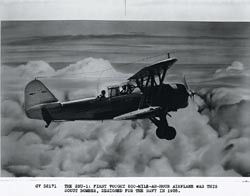|
 In 1932 the Navy again revived the two-seat project. As a result, Bureau of Aeronautics design number 113 was sent out to industry for bids. The main feature of this design was the use of the new Pratt & Whitney Twin Wasp engine. Eugene Wilson, who had been the engine section chief during development of the engine and was now the chief executive of Vought Aircraft, knew personally the political football the two-seat fighter concept had been. In order to ensure some return on investment for the two-seat fighter bid, he had it built structurally strong enough to meet the design requirements for a dive bomber. This type of airplane had received interest in the Navy ever since the Marines had successfully used the O2U Corsairs as dive bombers in Nicaragua in 1929. In 1932 the Navy again revived the two-seat project. As a result, Bureau of Aeronautics design number 113 was sent out to industry for bids. The main feature of this design was the use of the new Pratt & Whitney Twin Wasp engine. Eugene Wilson, who had been the engine section chief during development of the engine and was now the chief executive of Vought Aircraft, knew personally the political football the two-seat fighter concept had been. In order to ensure some return on investment for the two-seat fighter bid, he had it built structurally strong enough to meet the design requirements for a dive bomber. This type of airplane had received interest in the Navy ever since the Marines had successfully used the O2U Corsairs as dive bombers in Nicaragua in 1929.
Proposals for the two-seat fighter were received from seven manufacturers. The Douglas XFD-1 and the Vought XF3U-1 were selected for construction and evaluation. With favorable reports from the Navy tests of the XF3U-1, Vought suggested the airplane be further tested as a scout bomber and replacement for the SU series of airplanes currently in the inventory. These tests showed the XF3U-1 had a projected range of 858 miles and a cruising speed of 150 mph compared to a range of 635 miles and a cruising speed of 130 mph for the SU’s
|